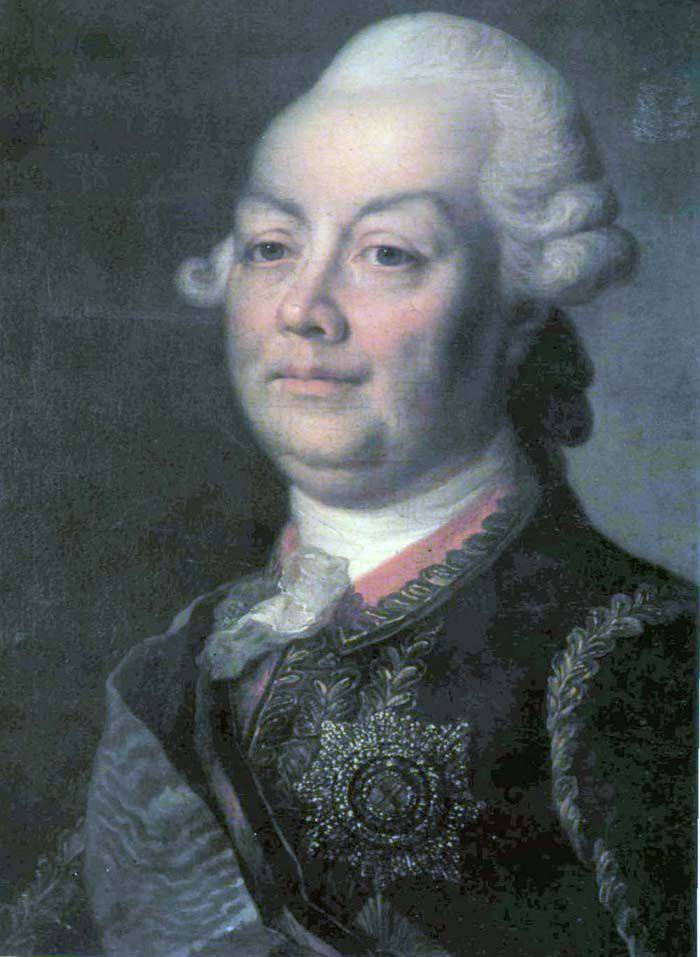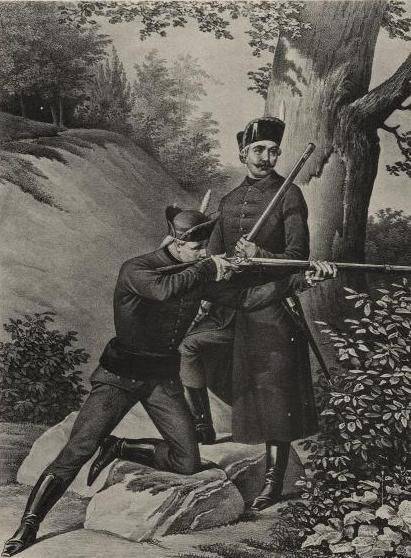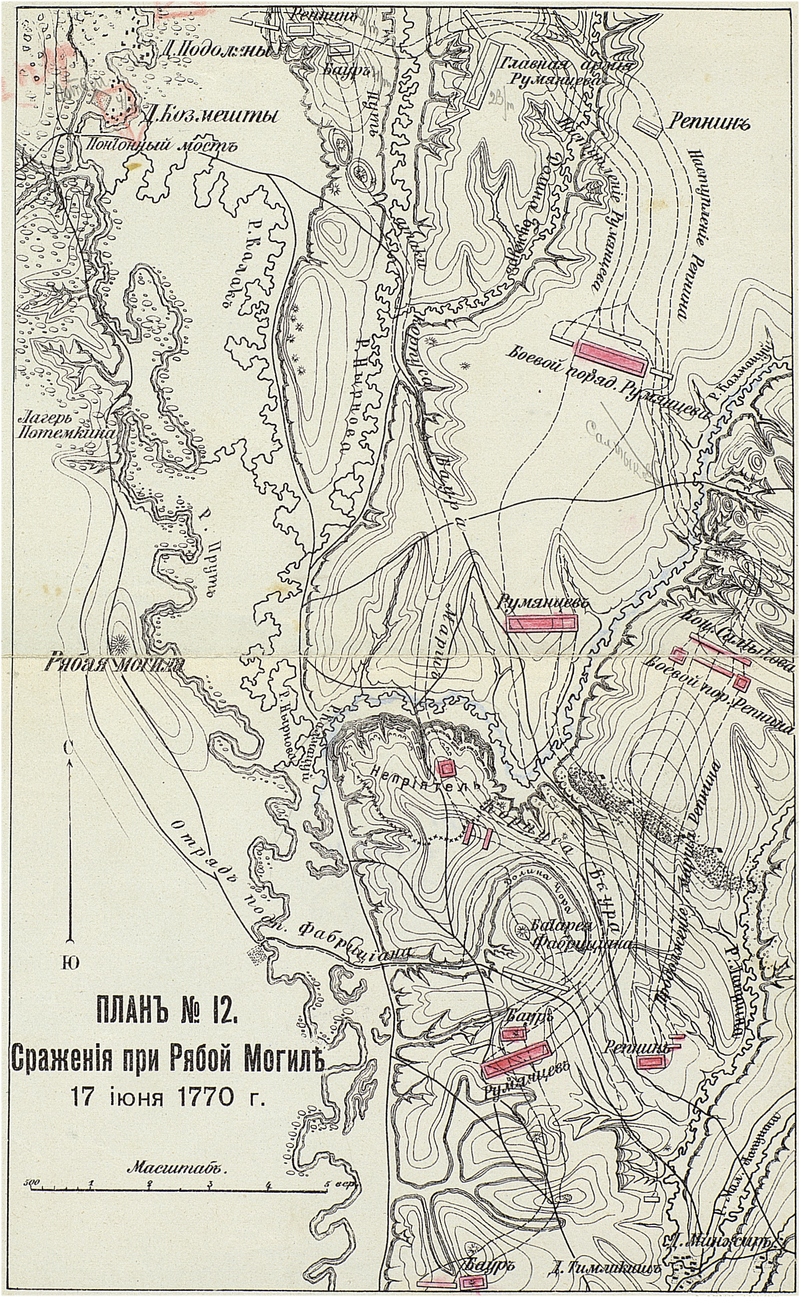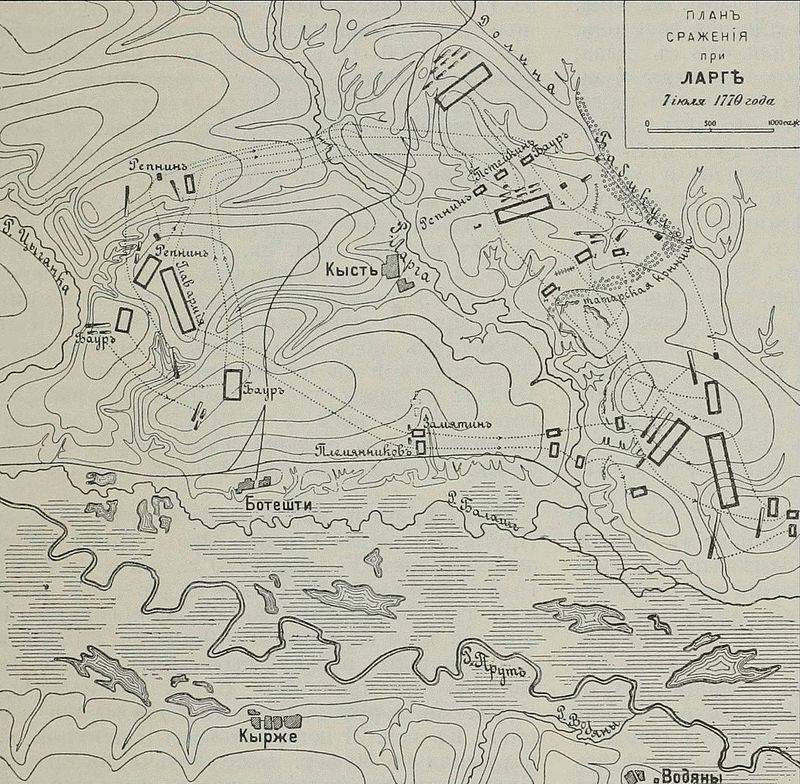Brilliant victories of the Russian army under the leadership of P. A. Rumyantsev over the Turkish-Tatar troops: the battles at Ryaba Mohyla and Larga
prehistory
The battle took place during the Russian-Turkish war 1768 — 1774. The reason for the next clash between Russia and Turkey was the events in Rzecz Pospolita. Polish-Lithuanian Commonwealth has long degraded due to fundamental internal contradictions has become the scene of confrontation between internal parties and external forces. When King August III died in Poland in 1763, the usual feuds of parties began. The other great powers intervened. Russia stood for King Stanislav Ponyatovsky. The Bar Confederation (military-political union of the Polish nobility), supported by Austria and France, opposed Russian influence. A war began in which the Confederates fought against Russian and Polish government forces.
The French actively tried to incite the Ottoman Empire on the Russians. Under French pressure, the Confederates agreed to cede Volyn and Podolia to Turkey in the event of a favorable outcome of the war. Istanbul, who wanted to retain its influence in the Northern Black Sea region and prevent further strengthening of Russia in the region, decided to intervene in the war.
The Ottomans used the border incident in the city of Balta, which was under the influence of the Ottoman Empire, as a pretext for war. The Ottomans threw the Russian ambassador Obreskova into the seven-tower castle, which meant a declaration of war according to Ottoman custom. October 29 (November 10) mobilization began in Turkey. Porta accused Russia of violating the prisoners' treatises, building fortresses near the borders of Turkey, intervened in the affairs of the Commonwealth, trying to limit the freedom of the Poles and contributing to the election to the throne “a man from among officers, unworthy to be a king, and no one from whose name and ancestors was not the king "; finally, the fact that the Russian troops ravaged the Balta. In response, Russian Empress Catherine II declared war on Turkey with a manifesto from 18 (29) on November 1768.
In winter, both powers were actively preparing for hostilities. The 1769 campaign of the year generally ended in favor of Russia. Russian troops occupied Khotyn, Iasi. Turkish troops retreated beyond the Danube. However, the main Russian army under the authority of Prince A. M. Golitsyn acted hesitantly. The Empress, dissatisfied with the defensive nature of Golitsyn's actions, made him field marshal general and recalled him from the army. In his place, she appointed Rumyantsev. The general had previously commanded the 2 Army, which defended Russia's southern borders from the invasions of the Crimean Tatars. In November, Russian troops occupied Bucharest and advanced forward detachments to the left bank of the Danube.
Rumyantsev, despite his relatively weak strengths and lack of food, decided to act offensively. According to the military action plan drawn up by the Rumyantsevs for the 1770 campaign, the main army was supposed to completely clear the Turks of Wallachia and Moldova and prevent the crossing of the main Ottoman army across the Danube, and the 2nd, acting in connection with it, to capture Bender and protect the southern borders of Russia. At the same time, the First Baltic Archipelago Expedition fleet under the leadership of Alexei Orlov and Grigory Spiridov, she was to support the Greek uprising against the Ottoman yoke in the Peloponnese (Morea), disrupt the communications of the Ottomans in the Mediterranean Sea and, if successful, block the Dardanelles. The uprising did not succeed, but the Russian squadron destroyed the Turkish fleet in Chesmenskaya Bay (Chesma; Part 2) and diverted considerable Ottoman forces to themselves, which contributed to the actions of the Russian army on the Danube.
Rumyantsev
Peter Alexandrovich Rumyantsev entered history as one of the best Russian generals. Rumyantsev formulated the principles of offensive strategy and tactics and, along with Suvorov, rightfully became the founder of the Russian military doctrine. Rumyantsev was a supporter of the most resolute offensive tactics and sought to make full use of the cold weapon infantry. Russian bayonet attack more than once decided the outcome of the battles in favor of our army. Rumyantsev preferred to beat the masses of the enemy in the field, without losing time on the siege of the fortresses, believing that after the defeat of the field troops, the strongholds would fall.
Pyotr Alexandrovich Rumyantsev was considered among contemporaries as a man of mystery. This was largely due to its origin. Officially, he was the son of an outstanding diplomat and associate of Tsar Peter Alexander Ivanovich Rumyantsev and Maria Andreevna Matveyeva. According to another version, Maria Matveyeva was Tsar Peter's mistress, and he was the illegitimate son of the Russian emperor.
Under Empress Anna Ioannovna, the Rumyantsevs fell into disgrace and spent several years in exile in the territory of Sarovsky district. At the age of 10, Pyotr Aleksandrovich was enrolled as a private soldier in the Life Guards Preobrazhensky Regiment. In 1739, he was enlisted in the diplomatic service and sent as part of an embassy to Berlin. However, Peter’s diplomatic career did not work out. He led a riotous lifestyle, so already in 1740, he was recalled for "prodigality, laziness and sabotage" and was enlisted in the Ground gentry corps.
Rumyantsev did not stay in this educational institution either. The cadet-hooligan left the corps and was sent to the army in the rank of second lieutenant. During the Russian-Swedish war 1741-1743. the young officer gained his first combat experience by fighting near Wilmanstrand and Helsingfors. On the battlefield, young Rumyantsev was distinguished by great courage and care for his subordinates. At the same time Rumyantsev continued his tricks. His father wrote: “I have come to that: either my ears should be sewn up and you can’t hear your bad deeds, or deny you ...”. In 1743, with the rank of captain, he was sent to St. Petersburg with the news of the signing of the Abos peace treaty. Empress Elizaveta Petrovna, when she received this report, produced a young man immediately as a colonel and appointed her commander of the Voronezh Infantry Regiment.
Elizaveta Petrovna favored the Rumyantsev family, which contributed to the career of a young officer. In 1748, Col. Pyotr Aleksandrovich took part in the campaign of the Russian expeditionary force on the Rhine, and a year later he lost his father. The death of his father greatly influenced Peter Alexandrovich, he came to his senses.
By the beginning of the Seven Years' War, Rumyantsev already had the rank of major general, commanded an infantry brigade. He distinguished himself at the 19 (30) August 1757 Gross-Egersdorf battle. His brigade was in reserve behind the Norquitten Forest, which was considered impassable. Rumyantsev found out that the forest, although swamped, is passable. In the midst of the battle, when it seemed that the Russian army would be defeated, Rumyantsev, on his own initiative, led the brigade regiments through the forest and struck the open flank of the enemy. A.T. Bolotov, who participated in this battle, wrote about this: “These fresh regiments did not hesitate for a long time, but having fired a volley, with a cry of“ Hurray ”they rushed straight at the bayonets against the enemies, and this decided our fate and made the desired change.” The Prussian army was defeated. However, the commander S. F. Apraksin did not even mention Rumyantsev in a report to the empress, as he envied his talent and considered it an upstart.
In 1758, Rumyantsev received the rank of lieutenant-general and led the division. The troops of Saltykov and Rumyantsev occupied Königsberg, and then all of East Prussia. 12 August 1758, the Rumyantsev division played a decisive role in the battle near the village of Kunersdorf in Silesia. The battle of Kunersdorf put forward Rumyantsev among the best commanders of the Russian army, for which he was awarded the Order of St. Alexander Nevsky. In the 1761 campaign, the corps under the command of Rumyantsev distinguished itself by taking the powerful fortress of Kolberg. For the first time in the history of Russian military art, the elements of the tactical system of the column - loose formation were used during the siege of Kohlberg.
When Elizabeth died, Peter III made peace with Prussia, depriving Russia of the fruits of the victory that had already been won, but noted Rumyantsev with orders of St. Anna and Andrew the First-Called and conferred on him the rank of General-in-Chief. Apparently, Emperor Peter wanted Rumyantsev to lead the army in the upcoming Danish campaign. After the palace coup, when Empress Catherine II came to the throne, Rumyantsev, thinking that his career was over, filed a resignation. But the new empress did not offend the honored commander. Catherine kept him in the service, and in 1764, he appointed the Governor-General of Little Russia.
In the 1768 year, when the war began with the Ottoman Empire, Rumyantsev was appointed commander of the 2 army, which was to defend the Russian borders from the raids of the Crimean Tatars. After Prince Alexander Golitsyn failed to justify his trust in 1769, Rumyantsev led the main army.
Rumyantsev combined extraordinary quickness of mind with intelligence, courage with composure. All his actions were distinguished by their peace of mind. Rumyantsev never doubted. He always tried to be between the soldiers, delving into their needs, and at the same time worked a lot with the papers. Rumyantsev paid special attention to maintaining discipline among the troops. Petr Aleksandrovich said: “by indulgence one can spoil the best army.” At the same time, his rigor was always inseparable from justice. Therefore, Rumyantsev enjoyed universal love among officers and soldiers.

Portrait of P.A. Rumyantsev-Zadunaisky work by an unknown artist of the end of the XVIII century
Russian army. 1770 Campaign of the Year
The Russian army during this period was divided into divisions and corps, which did not have a certain composition. Divisions and corps consisted of brigades reinforced by regimental and field artillery and cavalry. The infantry brigade consisted of two regiments or several grenadier battalions. Infantry regiments consisted of 2 battalions; Grenadier battalions consisted of 4 grenadier companies, and musketeer battalions of 1 grenadier companies and 3 musketeers. According to the state in the battalion was 650-700 fighters, but in reality of the various losses (in battle, due to illness, etc.), the number of battalions was much lower. So, in the battle of Kagul in battalions there were only from 350 to 500 fighters. Sometimes divisions were given Jaeger battalions.
In battle, the infantry was built in four lines, while the first two were kneeling when firing. Columns were used only for marching troops. Musketeers were armed with guns with bayonets and swords, and the grenadiers, in addition, had two grenades in special bags. Rangers had shotguns of a shortened design with long flat bayonets. Sometimes part of the infantry armed with peaks, for this in each regiment it was necessary to have a peak for 216. In addition, to repel equestrian attacks, 3500 rotogravat copies (slingshots) were carried in each regiment, and with them, solid slingshots were built with the help of loops and bows. Rumyantsev, due to the fact that the slingshots themselves had already become obsolete, canceled them, believing that the Russian infantry should attack by suppressing the enemy with fire and bayonet attacks, and not passively defend themselves. However, the slingshots completely became obsolete only in the next war with Turkey.
Cavalry was divided into brigades, which consisted of 2 regiments. Cuirassier and Carabinieri regiments consisted of 8 mouth, or 4 squadrons. Also had a 1 spare squadron. Hussar regiments consisted of 16 mouth or 8 squadrons with 2 spare squadrons. The number of combat-ready people in squadrons did not exceed 60-80.
The cavalry in battle was built in three rows, when dismounted - in two. Cuirassiers were armed with broadswords, two pistols and worn iron cuirass, the carbines had a carbine with a bayonet, a couple of pistols, a broadsword, and hussars — carbines, pistols, and a saber. Artillery was divided into field and regimental. Field artillery consisted of mouths, along 10-12 guns in each. The regimental artillery was attached to infantry regiments. Each regiment had four 3-pounders.
During the battle with the Turks, the troops were built in a square with guns. Regimental guns were located on the flanks of the battalions, field - on the corners and in the middle of the long faces of the square. Part of the infantry was located inside the square, as a reserve, or as a separate small square. They were fired by rows and platoons (plutongs). The cavalry was located in the intervals between the square.

The rangers, from 1765 to 1786
The goal of the 1770 campaign for the year was to complete the conquest of the territory that was on the left (eastern) side of the Danube. For this it was necessary to take Bender. This task was assigned to the 2 of the Russian army. The 1 Army had to cover the Danube direction, parrying the strike of the Vizier’s army. The total number of 1-th Russian army reached 50 thousand. Bayonets and sabers. In the 2 Army, there were up to 30 thousand regular and about 17 thousand irregular troops.
The enemy had large masses of troops. About 80 thousand Tatar cavalry gathered at Chisinau. The main Ottoman army, which was planned to increase to 150 thousand people, gathered on the Lower Danube, in Isacchi. The Ottoman sultan, dissatisfied with the failures of the troops, appointed Khalil Pasha to the place of the vizier, and to the place of the Crimean khan Devlet-Girey Kaplan-Girey.
At the end of April, 1770, leaving the Corps under the command of Lieutenant-General Christopher von Essen (about 10 Thousands of Soldiers) in Rzecz Pospolita to cover the rear of the army, the main army left the winter apartments and moved toward Hotin. May 15 troops Rumyantsev crossed the Dniester. Part of the troops (6 infantry and 4 cavalry regiment) were left in the fortress and to protect the crossings of the Dniester. The bad weather, the rains that ruined the roads, forced the Russian troops to stand on the Khotin 10 days. Troops made only 25 May. 9 June Rumyantsev camped on the left bank of the Prut near the village. Zicora (30 versts from Yass).
Meanwhile, the Turkish command tried to build a crossing on the Danube, but because of the large flood of the river, this was not possible. Vizier confined himself to having ferried 10-thousand. the hull on the boats, which was sent to Chisinau to help the khan. After receiving reinforcements, the Tatar Khan Kaplan-Girey attempted to force Prut, but was retained by Shtofeln’s corps.
The Shtofeln Corps waged a stubborn struggle against the enemy in Wallachia all winter. The epidemic of plague greatly thinned the ranks of the compound. In April, 1770 Rumyantsev ordered to leave Bucharest and the whole of Shtofeln’s corps to join up with the main forces. 11 June, the new commander of the Moldavian Corps, Repnin, who replaced Shtofeln, who died of the plague, crossed over to the left bank of the Prut to join the vanguard of the main army of Rumyantsev. There are only about 5 thousand people left in Repin’s building.
At this time, the main forces of Rumyantsev consisted of two advanced (avant-garde) corps of Generals Baur and Repnin, three divisions Olitz, Brusss and Plemyannikov. The number of Russian army was about 30-31 thousand fighters and 5 thousand non-combatants, and they were opposed by about 70 thousand Tatars and 80 thousand Ottomans.
Victory at Speckled Tomb and Larga
The 15 (26) of June, the avant-garde of Baur overturned the advanced units of the Kaplan-Giray army and forced them to retreat to the main forces beyond the Kalma creek, at the Speckled Tomb. It must be said that the activities of quartermaster-general Friedrich Wilhelm Bauer (Bauer) contributed greatly to the successes of Rumyantsev. This general was the chief assistant, Rumyantsev's right hand. Baur had a good military education, was able to build bridges, various structures, and conduct sieges. He was well versed in topography (he made a model map of Moldova).
Rumyantsev wanted to attack the army of the Crimean Khan in the morning of June 17 (28). According to his plan, the Russian army was divided into several separate detachments that attacked the forces of Kaplan-Girey simultaneously from several sides. However, frightened by the encirclement, the Tatar Khan did not dare to accept the fight, although he had superiority in forces. The Tatar army retreated to the Larga River, losing 400 people. The Russian army lost only 46 soldiers.

In fact, it was a small skirmish, but she became famous because of the tactical innovations used by Rumyantsev. For the first time during the steppe campaigns of the Russian army, General Rumyantsev used a divisional square, not being afraid to divide the troops. Prior to this, the Russian army used a single army vehicle in the fight against the enemy with a large mass of cavalry (Tatars and Ottomans). In addition, Petr Aleksandrovich stopped using barrage slingshots in order to increase the mobility of troops and increase the force of the volley (previously, some soldiers were used to carry slingshots and did not fire). Now, to cover the infantry from the attacks of the enemy cavalry, they actively used artillery, the infantrymen met the enemy with guns and bristled with a wall of bayonets. These innovations increased the maneuverability of the troops, made the actions of the Russian army faster, more decisive and attacking.
The Tatars united with the Turkish detachment under the command of the Moldavian seraskir Abdy Pasha, and the number of enemy troops increased to 80 thousand people. The Turkish-Tatar army was located in four fortified camps on the heights beyond the river Larga.
General Peter Rumyantsev, joining the Potemkin detachment and leaving part of the forces in Falch, to cover the crossings and warehouses with supplies there, went to Larga. The Russian army settled on 4 (15) in July before reaching the river, 5 versts from the enemy camp. Several days passed in clashes. Tatar cavalry constantly worried advanced Russian parts. However, each time the enemy was rejected.
Peter Rumyantsev, despite the superiority of the enemy (the Russians had the advantage only in artillery - 115 guns against 33), decided to attack first. The Russian commander wanted to prevent the Tatar cavalry from uniting with the army of the Ottoman vizier, who was still beyond the Danube. General Rumyantsev decided to deliver the main blow on the right flank of the Khan's army, wanting to push the Tatar cavalry back to the Prut River. To solve this problem were two avant-garde corps of Baur and Repnin, and all the other troops of the army, except for the division of Plemyannikov. The division of Plemyannikova received the task of attacking the enemy camp on the left flank, distracting the Tatars from the place of the main attack.

To amaze the enemy with surprise attacks, Rumyantsev decided to strike on the night from 6 to 7 (18) in July 1770. All the wagons were sent to Wagenburg (mobile field reinforcement from carts). Pyotr Aleksandrovich, considering the bayonet to be the best defense of the Russian infantry, decided to attack the Tatar cavalry without slingshots. And in order to further mislead the enemy, he ordered, at nightfall, to set up and maintain large fires. Tatars and Turks should have considered that the Russians were still in their camp.
The Baur Corps was transferred from the right to the left wing. The quartermaster general was instructed to arrange a 4 bridge across the Larga, above the Tatar camp, to cross to the other side and occupy the heights in order to cover the crossing of the main forces of the army. The troops of Baura fulfilled the task set: they crossed the river and lined up in a square. However, the forces of Baur clashed and overturned the advanced chain of enemy riflemen, who by their flight alarmed the entire Turkish-Tatar army.
Meanwhile, Repnin's corps was built in two squares, and it stood in line with Baur's troops. Three Russian squares went on the attack on the right wing of the enemy. Behind them, the rest of Rumyantsev's troops moved in reserve, which made up one large square. The cavalry moved behind the main forces, the Cossacks and arnauts (auxiliary troops made up of people from the Balkans) were sent around, behind enemy lines.
The Turks opened heavy fire from the guns on the advancing Russian troops. But they were shooting in a hurry, and the skills of the Turkish gunners were low, so there was little harm from this attack. Therefore, the troops of Baur and Repnina captured two camps and rushed to the third. The Tatar cavalry attempted to counterattack, rushing around the left face of a large square, but was repelled by Russian artillery with frame fire. At this time, on the left flank of the Turkish-Tatar army, the division of Plemyannikov attacked. Turks and Tatars ran. Many enemies overtook and killed, others drowned in Prut. But most successfully escaped. The Russian army did not have enough light cavalry to intercept the light cavalry of the Tatar Khan.
The battle ended with a complete victory for the Russian army. How many people lost the Khan's army is unknown (according to some information more than 1 thousand people). For our part, according to Rumyantsev, the entire 91 man was killed and wounded. 33 guns, several banners and a rich wagon train became Russian trophies.
Meanwhile, Count Panin with the 2 th army 7 June crossed the Bug, July 2 across the Dniester. 15 (26) July Panin's army overlaid Bender. Panin decided to take Bender not by storm, but by a siege, which lasted until September, when Russian troops took the fortress by storm.
To be continued ...
Information